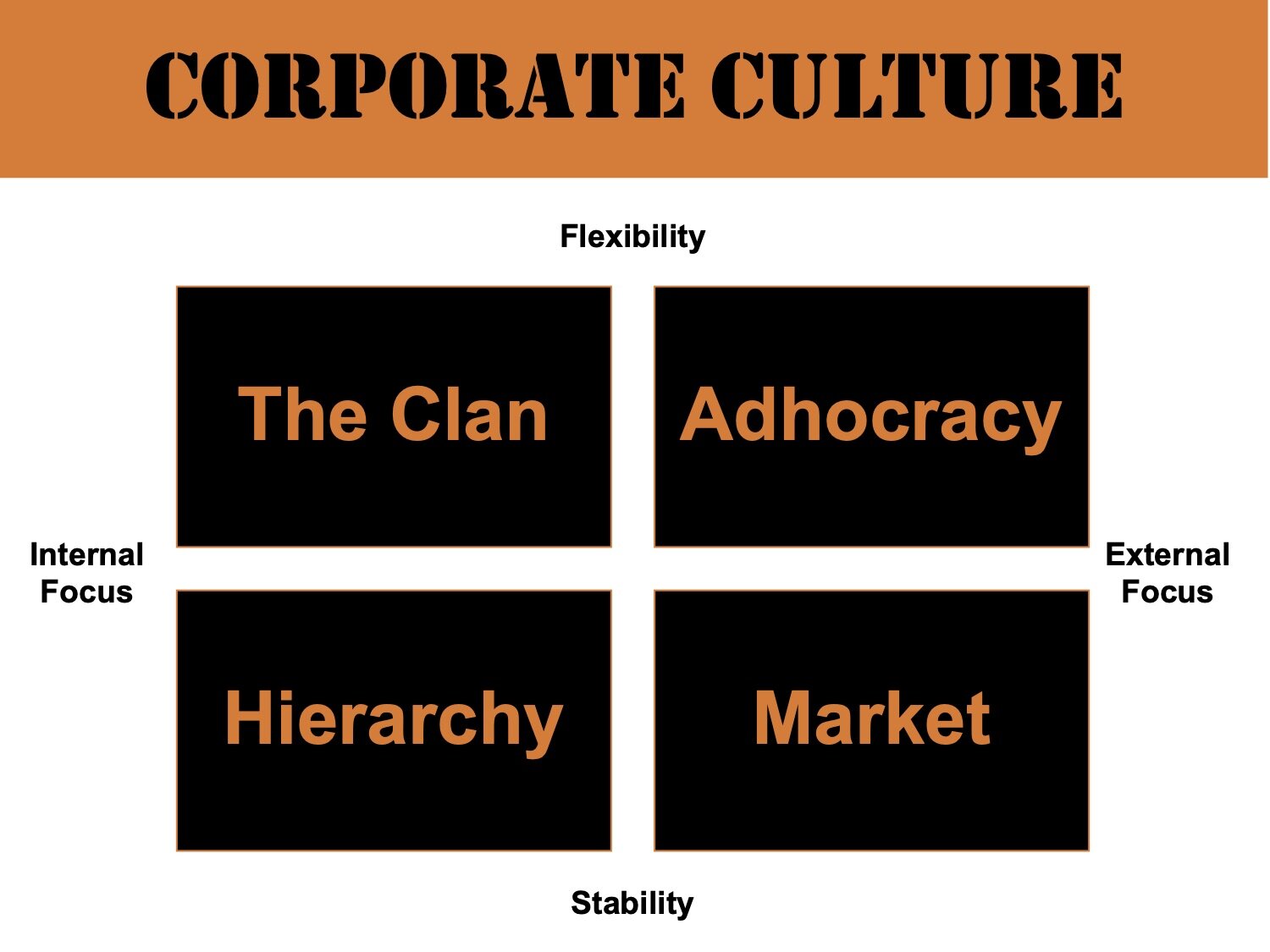4 Types of Corporate Culture (#48)
One of the building blocks of any exceptional organization is a superb culture. Culture is defined as the beliefs, values, and behaviors that determine how an organization’s people interact and behave both inside and outside the organization. Previously, I discussed how organizations utilize their history and the After Action Review (post #33 ) to enhance their culture.
It is useful to understand what type of corporate culture is dominant in your organization. University of Michigan business professors Robert E. Quinn and Kim S. Cameron developed the Organizational Culture Assessment Instrument (OCAI) as a way to assess organizational culture. Working with over 12,000 companies, their research determined that there were four predominant company cultures: clan, adhocracy, market, and hierarchy. While each organization has a dominant culture, every organization exhibits its own unique combination of the four types.
Clan Culture
Clan cultures are a friendly, collaborative cultures that are like a large family, or clan, where people have a lot in common. This type of culture likes to “do things together.” The clan culture favors flexibility with an internal focus. People in these organizations form strong bonds of loyalty, tradition, and congruence. Examples of companies that may have a clan culture include Ben and Jerry’s, Pixar, and Love’s Travel Stops.
Adhocracy Culture
The base of this culture is the concept of “ad hoc.” An adhocracy culture is a dynamic and innovative environment where employees are willing to take chances and leaders are typically seen as inspirational innovators willing to challenge assumptions and take risks. An adhocracy favors flexibility while staying externally focused. This type of culture likes to “do it first.” The core values of the culture are change and agility. Examples of companies that may have an adhocracy culture are Tesla and DoorDash.
Market Culture
A market culture is a culture in which the goal is to get down to business, get work done, and achieve results. This is often a competitive environment, even among coworkers. The market culture emphasizes stability while staying externally focused. This type of culture likes to “get the job done.” These companies goal is to make as much profit and capture as much market share as possible. Companies that may have a market culture include Amazon and historically, Ford Motor Company under Henry Ford.
Hierarchy Culture
Hierarchy cultures emphasize process and procedure. Leaders ensure that the employees follow the “company way” — the tried and true ways of doing business. This type of culture likes to “do things right.” The companies focus on following the rules and guidelines to reduce costs and make few mistakes. Many of the military units I were part of had a strong hierarchy culture. Other organizations that may have a hierarchy culture are NASA, ExxonMobil, and General Electric.
The battalion I commanded in Afghanistan had six companies each with its unique combination of cultures. Angel Company was more of an adhocracy and wanted to lead the way. Battlehard Company was more of a clan, tackling problems together. Choppin’ Company was more of a market, get the job done, culture. And finally, the Forward Support Company was a hierarchy — they needed to follow the rules to provide logistical support to all the other organizations.
There’s no correct organizational culture for a small or medium sized business, non-profit organization, or sports team. Each culture type promotes some forms of behavior while inhibiting others. Some are well suited to rapid change and growth, while others work better to slowly, incrementally develop the organization. As your organization evolves it may begin as an adhocracy as a start-up and then transition to a market or hierarchy when it is larger.
Knowing what type of culture your organization has is an important step in growing and developing it. Two questions to ask yourself and your team — what type of culture predominates in your organization? And is it the type of culture that will help you grow and develop your organization going forward?
Conclusion
If you’d like more ideas on how to improve the culture in your organization take a look at Chapter 15 in my book, Grow Your Grit, available for sale at Amazon. Or hit one of the buttons below to start the conversation about improving the culture in your team.
In the meantime, go on the offensive and use the understanding of the four types of corporate culture to start improving your culture today.

